|
S u d - E x p r e s s
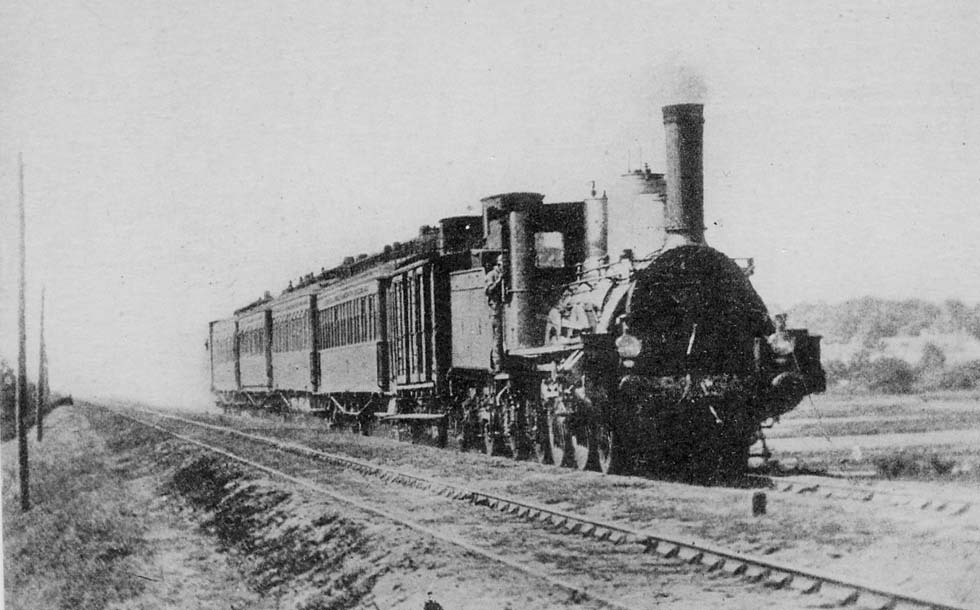
Sud-Express, 2-4-2 type engine no.343 in France 1896 (old postcard and contemporary press)
Don Luis : Paris est à nous
Dona Hortensia : A la colonie
L' Infante : Eh ! ne dites pas: la colonie.
Qu' est-ce, la colonie étrangère ?....
Nous ne sommes chez nous réellement que
dans le Calais - Nice ou le Paris - Vienne, ou
Le Sud-Express…..
Abel Hermant
Trains de Luxe
(play, 1909)
|
Entre Cordoue et Séville
Est une petite station, où, sans raisons apparentes,
Le Sud-express s' arrête toujours.
En vain le voyageur cherche des yeux un village….
Pourtant, de l' autre côté de la voie, en face,
Il y a une hutte faite de branchages noircis et de terre.
Et au bruit du train une marmaille loqueteuse en sort.
La sœur aînée les précède, et s'avance tout près sur le quai
Et, sans dire un mot, mais en souriant,
Elle danse pour avoir des sous.
Valery Larbaud
|
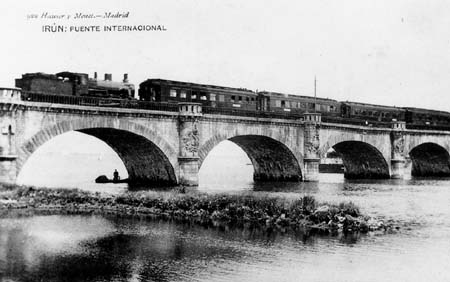 Spanish CIWL Sud-Express at Irun 1911 (coll. Wilhelm Tausche)
Spanish CIWL Sud-Express at Irun 1911 (coll. Wilhelm Tausche)
Georges Nagelmakers dreamt since his boyhood of grand international expresses passing through his Belgian home town Liege - and the Nord-Sud-Express St. Petersburg - Lisbon and Calais should fulfill his dream. However, Prussia’s nationalism prevented it and so his CIWL could start in 1884 only the Sud-Express from Paris, initially also Calais, to Lisbon via Madrid. Due to the Spanish broad gauge, passengers had to change train at Irun, northbound at Hendaye. In Spain in the beginning still 6-wheeled cars were used and in France the train ran from 1900 during daylight hours and sumptuous saloons were introduced.
The Sud-Express was not the only train connecting with the steamers for Central and South America. England's Great Western had the "West Indian Boat Express" and in France the CIWL Timetable (e.g. in 1927) mentioned a "Wagon-Lits ou Wagon-Restaurant entre Paris - Bordeaux (Amérique du Sud)" for Chargeurs Réunis, a Wagon-Restaurant Paris - Boulogne and Cherbourg for Blue Star and Royal Mail to South America and a "Wagon-Lits entre Paris - Saint-Nazaire (Amérique Centrale)" for the French Line.
The French Sud-Express was equipped from 1926 with all-steel Pullman saloons, initially painted brown/cream. And Ferrocarriles Andaluces started their own El Andalus with a brown/cream CIWL-like Coche Salon Pullman type, some ones later converted into green “Coches Butacas”. Between the wars blue all-steel S class sleepers replaced the wooden ones on the Spanish Sud-Express. An ultimate extension to Algeciras with boat connection to Morocco was tried, without success. The Spanish civil war and then World War II interrupted the Sud-Express only temporarily on certain sections. And the Iberian peninsula became a way to escape from the Nazis. Also after Hilter’s meeting with Franco at Irun railway station in 1940, Spain stayed neutral. At the northern side of the border, at Hendaye, started the D36 with a Mitropa sleeper for Berlin and connections to Sofia and from there to Istanbul - for anyone who got this privilege by Guardia Civil and Gestapo….
Still after the war the French Sud-Express had two Pullman cars, but now also ordinary coaches. In 1953 it was speeded up with Europe's longest non-stop run Paris - Bordeaux and then equipped with 1st class stainless steel coaches additionally to the Pullmans. Old coaches added in Spain had the comfortable "Butacas" compartments, and of course there were sleepers, diners and mail vans by the Wagons-Lits company. Introduction of the Puerta del Sol Paris - Madrid with UH sleepers, later also couchette cars, with interchangeable bogies and in Spain temporarily a cinema car, meant the end of the Sud-Express to Madrid.
Migrant workers were the new passengers on the Sud-Express for Lisbon, now with couchettes Paris - Portugal as well as on the trains to Madrid, to Algeciras with connection to Morocco and on many shabby specials. With introduction of the high-speed TGV-Atlantique Paris Montparnasse - Irun, the French Sud-Express became a simple slow seasonal train for poor migrants and then its ruined label disappeared in France. Only Portuguese railways tried to maintain its image by announcing the daily arrival at Lisbon in three languages… "le Sud-Express de Paris".
Let’s remember the time when the Sud-Express had not only been the train of aristocratic passengers, but when it was driven by an aristocrat, the Duke of Zaragoza. In a Locomotive Magazine of 1911 he reported: “One noteworthy trip I made was on April 30th last with the Sud-Express, with a load of 250ts behind the tender, the fastest time was made between Miranda and Valladolid, a distance of 210km, for the train arrived at Miranda 45 minutes late, yet I was able to arrive in Valladolid on time. The average speed marked in the travel book is 65 km/h, and I was obliged to run the maximum of 90 in order to make the performance”.
Timetable extract, Oct. 1921:
Sud-Atlantique-Express Paris - Lisbon, Sud-Maroc-Express Paris - Algeciras, change of trains at Irun/Hendaye
| (2,4,7) | 10:20 | 10:20 | dep. | Km 0 | Paris q:d’Orsay | arr. | 23:30 | (3,5,1) | 22:20 |
| (3,5,1) | 21:15 | - | arr. | 1899 | Lisbon Rocio | dep. | - | (2,4,7) | 11:40 |
| | 12:00 | arr. | 1455 | Madrid Norte | dep. | 21:00 | | |
| (1,3) | 20:20 | dep. | 1460 | Madrid Atocha | arr. (4,5) | 9:00 | | |
| (2,4) | 14:02 | arr. | 2204 | Algeciras Port | Dep. (3,4) | 15:05 | | |
| | 21:00 | dep. | | Tanger | arr. | 07:00 | | |
| | 08:00 | arr. | | Casablanca | dep. | 18:00 | | |
Sud-Express
First CIWL train de-luxe Calais - Paris - Irun, Nov. 1887 (northbound Hendaye - Calais) :
1 F (van, 6-wheeler), 1 WRS (restaurant, e.g. no. 139), 2 WL (sleepers, e.g. 188 and from series 121-126), 1 F (4-wheeler).
1891 new stock, same formation.
Sud-Express
Irun - Madrid Norte / Atocha - Lisbon, Nov. 1887:
1 F (4-wheeler), 1 WR (6-wheeler, nos. 114, 116)
2 WL (6-wheelers, 108-110), 1 F (4-wheeler).
1891 new stock, WR and WL bogie cars, same formation, from 1895 Irun - Lisbon direct via Salamanca, on alternate days Irun - Madrid.
Sud-Express Paris - Irun, 1900:
1 F (6-wheeler), 1 WR, 2-3 WS (day saloons, then temporarily one for Biarritz - Ville), 1F (4-wheeler). Irun - Lisbon and Madrid daily, separated at Medina del Campo.
According to George Behrend for the Sud-Express in France were used WR 818-820, 909-910 and WS from series 770-773, 840-842, 956-965, 1501-1553 (originally in Belgium) and 1677-1678. In 1913 series 2443-2446 was built, intended for the Sud-Express.
For the Sud-Express in Spain WR 838-839 and WL 843-848 are mentioned.
Sud-Express
Irun - Lisbon / Madrid 1912:
1 F, 1 WR, 4 WL, 1 F
Colors: CIWL varnished teak, but 6-wheeler WL composite paneling
Sud-Express
Paris - Irun, departure Paris, '30s:
1 F, 4 WSP (day saloons, temporarily also one for Biarritz - Ville), 1 F
CIWL WSP all-steel series 2737-42 without kitchen, 2743-48 with kitchen, 2839-41 complementary cars with kitchen, all cars from 1926. From 1932 also "Etoile du Nord" type. Colors: Initially dark brown/cream, from 1932 dark blue/cream.
CIWL in Spain see Javier Aranguren: Coche Camas, Restaurantes y Salones. Madrid 1996. For CIWL cars see also Jean-Paul Lepage: Etat numerique CIWL. Champagne-sur-Seine, 1986.
Sud-Express
Madrid Norte, September 1960:
| Series 7500 (2CoCo2, dc) | RENFE | Madrid - Avila |
| 1 D (van) | RENFE | Madrid - Medina del Campo (?) |
| 1 WL (S3? sleeper) | CIWL | Madrid - Hendaye |
| 1 WL 2933 (sleeper) | CIWL | Madrid - Hendaye |
| 1 WL 2952 (sleeper) | CIWL | Madrid - Hendaye |
| 1 WR 3564 (restaurant) | CIWL | Madrid - Hendaye |
| 1 A (1st class) | RENFE | Madrid - Hendaye |
| 1 B (2nd class) | RENFE | Madrid - Hendaye |
Around 1947 also the S4 type sleeper and from 1956 the Lj type sleeper was used.
From Medina northward a Niagara 242F hauled the express combined with its Lisbon - Hendaye section, probably coupled immediately behind the engine. 241 F possibly Avila - Medina. To Irun electrified.
Colors: CIWL dark-blue, RENFE cars and electric engine light-green.
Sud-Express
Lisbon Santa Apolonia, Sept. 1960 :
| Series 1300 | (diesel) | CP | Vilar Formoso (?) - Lisbon |
| 1 F | (van) | CIWL | Irun - Lisbon |
| 2 WL (S3?) | (sleeper) | CIWL | Irun - Lisbon |
| 1 A | (1st class) | RENFE | Irun - Lisbon |
| 1 WR (ex WPB) | (restaurant) | CIWL | Medina (?) - Lisbon |
Irun - Medina del Campo with section Irun - Madrid Norte.
Colors: CIWL dark blue, RENFE light green, temporarily CP, green, CP diesel grey/green
Sud-Express
Paris - Austerlitz - Irun, April 1967:
| BB 9200 | (BoBo dc) | SNCF |
| 1 D2 | (van) | SNCF |
| 8 A (Inox) | (1st class, stainless) | SNCF |
| 1 WR | (restaurant) | CIWL |
| 1 WPA (Cote d' Azur) | (day saloon) | CIWL |
Colors: A stainless, WR dark-blue, WPA dark blue/cream, later replaced by red SNCF diner, BB9200 light-turquoise.
Sud-Express
Paris Austerlitz, May 11, 1970 (according to Maurice Mertens):
| CC 7114 (1.5 kVdc) | SNCF | Paris - Irun |
| 1 D2 (van) | SNCF | Paris - Irun |
| 5 B | SNCF | Paris - Irun |
| 4 A (Inox) | SNCF | Paris - Irun |
| 1 WR | SNCF | Paris - Irun |
| 1 WPA (4149) | CIWL | Paris - Irun |
| 2 A (Inox) | SNCF | Paris - Tarbes |
| 3 B | SNCF | Paris - Tarbes |
| 1 DP (ex P.O.) | SNCF | Paris - Tarbes |
Colors: WP type "Cote d' Azur" dark-blue/cream, SNCF green, Inox stainless, WR and DP red.
Sud-Express
Irun, March 4, 1979 (according to Maurice Mertens):
| BB 8904 (3kV dc) | RENFE | Irun - Medina |
| 1 D (van, Inox) | CP | Irun - Lisbon |
| 1 WL (ex-CIWL 3484 | CP | Irun - Lisbon |
| 1 Restauraute-Bar | CP | Irun - Lisbon |
| 1 A (Inox) | CP | Irun - Lisbon |
| 2 Bc (couchettes) | SNCF/Wasteels | Paris - Lisbon |
| 3 Bc (couchettes) | SNCF/Wasteels | Paris - Porto |
| 2 B (Inox) | CP | Irun - Lisbon |
| 3 B (Inox) | CP | Irun - Porto |
| 1 D (van) | CP | Irun - Porto |
Traction: From Medina diesel, to Lisbon CP 25kV ac BoBo Alsthom.
Colors: CP Inox, restaurant stainless, WL blue, SNCF Bc blue/grey; then Corail white/blue, RENFE locomotives green with yellow, CP Alsthom engines orange.
Sud-Express
Lisbon Santa Apolonia, Feb. 15, 2002:
| Series 5600 (BoBo ac Siemens/KM) | | CP | |
| 1 A | (1st class) | CP | Irun - Lisbon |
| 1 WLAB | (sleeper, rebuilt UH) | CP | Irun - Lisbon |
| 1 WR | (restaurant) | CP | Irun - Lisbon |
| 2 B | (2nd class) | CP | Irun - Lisbon |
| 1 Bc | (couchettes) | RENFE | Irun - Lisbon |
Before CP used rebuilt UH, S class sleepers ex-CIWL were in use.
Colors: CP stainless, sleeper dark blue, RENFE light-blue/cream, CP electric red/silver.
Traction (information also by Raymond Floquet, André Bègue, SNCF/Roche, Carles Salmeron Bosch):
PO: 2-4-2, 4-4-0, 4-4-2 types, from 1910 Pacifics series 3.500
Midi: 2-4-0, 4-4-0, 4-4-2 types, not the Pacifics
PO Midi: Pacifics 3.500, also Etat 231.500 and American 3.600, in '30s Pacifics rebuilt by Chapelon, also the streamlined 231.723
Electification 1.5KV dc Bordeaux - Hendaye 1927, initially 2C2 and 2BB2 (Ganz); Paris - Orleans 1926, to Bordeaux 1939, 2D2 5300 and 5500, various types.
SNCF: 2D2 5500, from 1954 CC7100, from 1960 also BB9200, from 1972 CC6500.
Norte: 4-4-0 types, from 1904 4-6-0, on mountain sections 2-8-0, around 1912 de Glehn Pacifics and then Hanomag 4cyl. compound Mountains (predecessors of RENFE 241-4000).
Electrification Alsasua - Irun in 1929, 1.5kV, then 3 kV dc, CC7000, 1CC1 7100, 2CC2 7200, 7300.
MZA (South of Madrid): From 1901 4-6-0 types, then Maffei 4cyl. compound Pacifics and Mountains (RENFE 241-2000).
Andaluces: From 1907 4-6-0 types, later Pacifics.
Oeste (formed in 1928 from predecessors): From 1907 4-6-0, then 4-8-0 types.
RENFE (formed in 1941), Sud-Express main line: Mountain types from predecessors (F equipped with oil firing), then 241-2200 from 1944, became 241F 2200, Miranda - Valladolid occasionally Pacifics 231-4000, Mikado 141-2000 and 4-8-0 type 240-4000, all ex-Norte, then also the streamlined Mountains 241-2100 ex-MZA, from 1955 to 1968 Niagaras ("Confederacion") 242F. Electrification continued, locomotives ex-Norte, new CC 7400, 2CC2 7500, then 269, 279 and 289. The new Burgos - Madrid line via Aranda remained diesel-hauled.
RENFE Medina - Vilar Formoso: 240 ex-Oeste, tank engines 242T ex-MZA, then Mountain 241F 2000 ex-MZA, then diesel, from '90s series 333.
Portugal (Beira-Alta and Cia. Real, 1947 united CP): 4-4-0 types, from 1906 4-6-0, from 1924 small Pacifics, Beira Alta 4-6-0 from 1909, temporarily also 2-8-4 tank engines from 1924 hauled the Sud-Express (unclear if the 4-8-0 from 1930 and the Middle East Mikados did ever haul the Sud-Express). Diesels from Alco and Baldwin 1951/52. Electrification 25kV ac, old blue BB, stainless BB, new BB Alsthom, then red/silver BB Siemens, after 2008 a new Eurosprinter derivative.
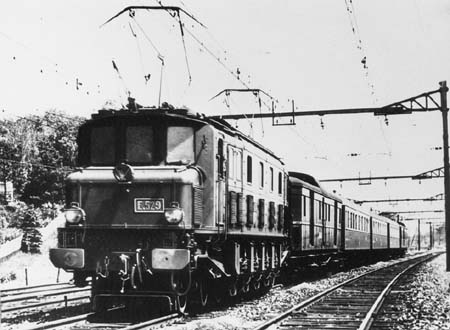
Sud-Express in France before WWII (coll. SNCF)
|
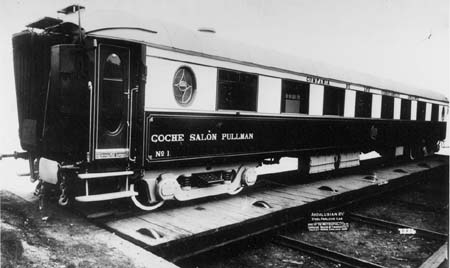
Coche Salon Pullman of El Andalus, Ferrocarriles Andaluces (Metropolitan Carriage W. & F. Co.)
|
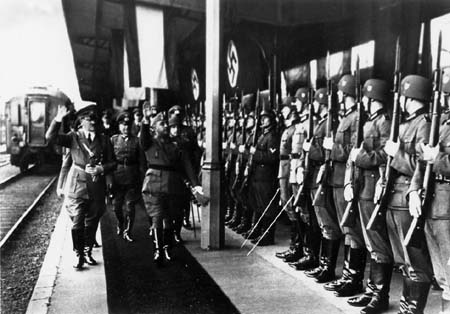
Franco and Hitler meeting at the Spanish-French border (old postcard)
|
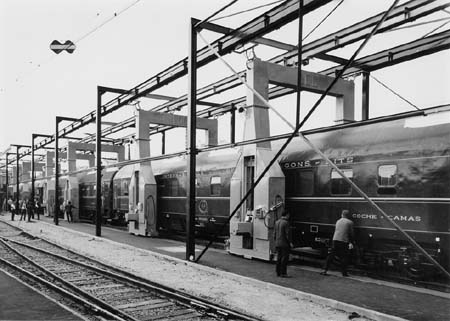
Puerta del Sol, CIWL sleepers UH changing gauge at Hendaye (SNCF)
|
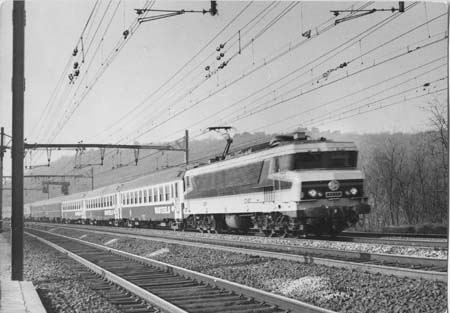
Puerta del Sol Madrid – Paris, SNCF class 6500, June 1977 (Marc Dahlstrom)
|
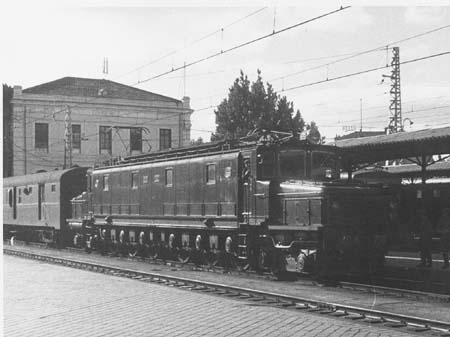
Iberia-Express Madrid – Hendaye, RENFE class 7500, Madrid Norte 1960 (WS)
|
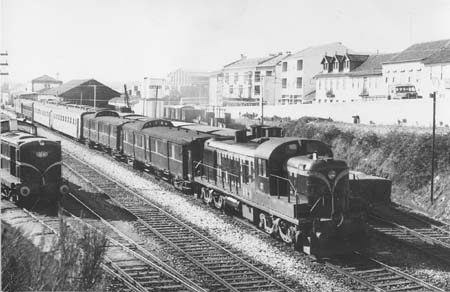
Sud Expresso Irun – Lisbon, CP class 1500, La Guarda in 1969 (Marc Dahlstrom)
|
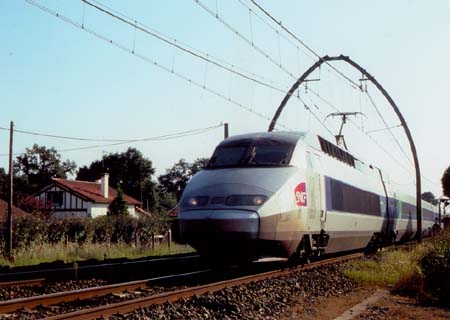
TGV Paris - Irun, south of Bordeaux, 2008 (Andreas Knipping)
|
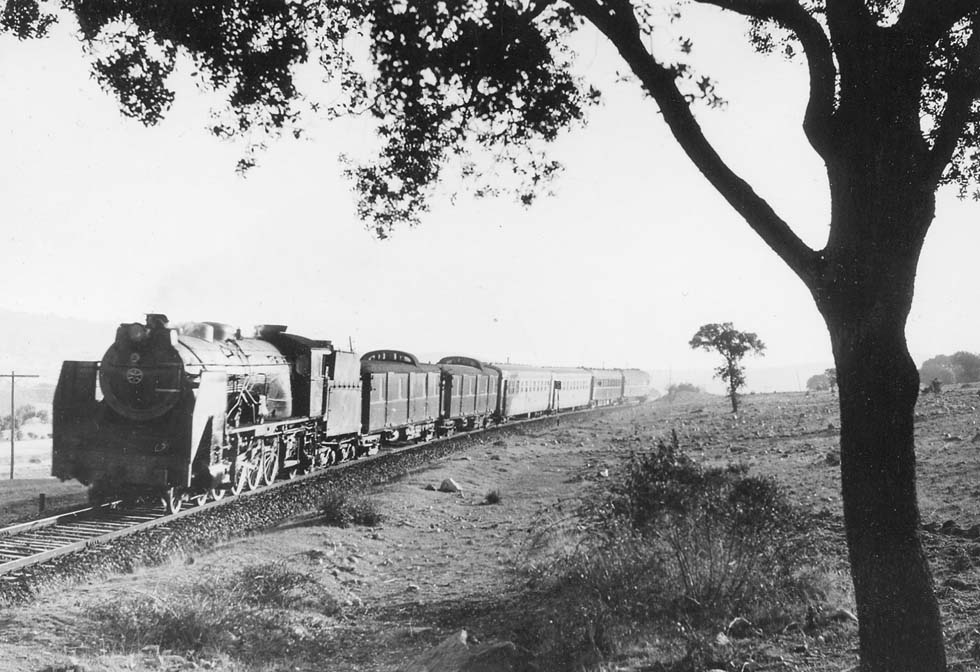
Sud-Express Irun - Lisbon, Maffei type Mountain ex-MZA, 2 CIWL vans, 2 stainless CP, CIWL sleeper and CIWL diner ex-Pullman, Ciudad Rodrigo, Spain, April 1969 (Marc Dahlstroem)
|